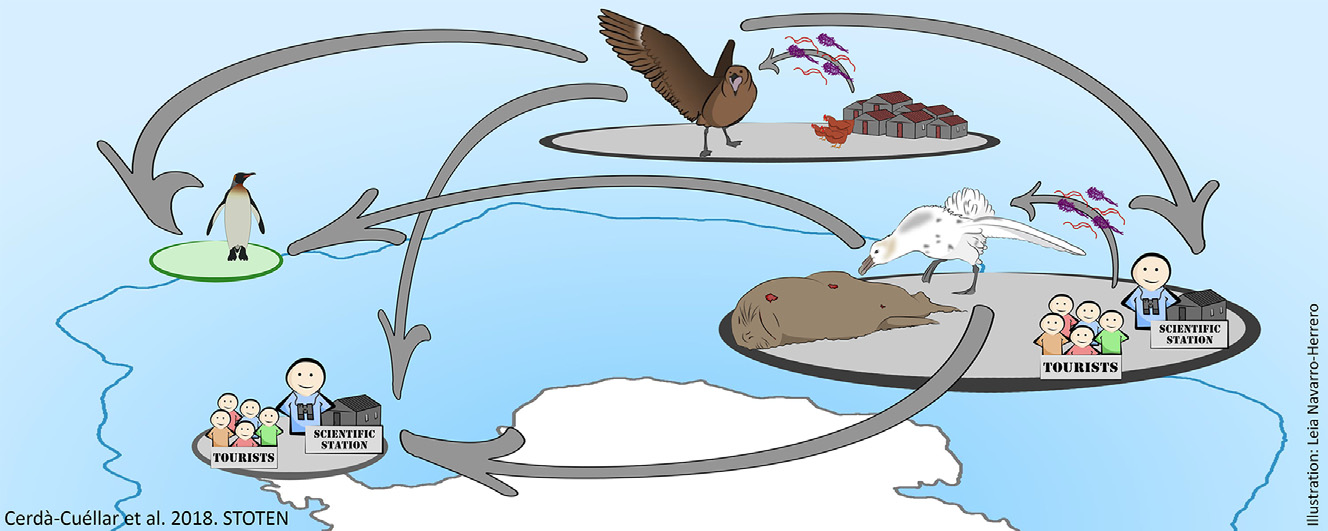Marta Cerdà-Cuéllar (Centre de Recerca en Sanitat Animal, Universitat Autonoma de Barcelona, Spain) and colleagues have published in the journal Science of the Total Environment on the likelihood of humans introducing bacterial infections to sub-Antarctic and Antarctic seabirds, including three ACAP-listed species.
Salmonella ser. Enteritidis was found in a Southern Giant Petrel Macronectes giganteus from Livingston Island, Antarctica. Campylobacter lari was found in a Southern Giant Petrel from Livingston Island and in two from sub-Antarctic Marion Island. Findings suggest “a reverse zoonosis in Antarctica, whereby zoonotic enteric bacteria have been introduced by humans to Southern Ocean ecosystems”. Sampled Northern Giant Petrels Macronectes halli and White-chinned Petrels Procellaria aequinoctialis were free of enteric bacteria. The paper concludes: “At Gough and Marion Is., introduction likely occurred through personnel based at the South African scientific stations, despite strict biosecurity controls for more than two decades. The introduction of these human-associated strains to these remote islands by migrating birds infected during migrating movements cannot be ruled out, but seems less plausible.”
The paper’s abstract follows:
“Reports of enteric bacteria in Antarctic wildlife have suggested its spread from people to seabirds and seals, but evidence is scarce and fragmentary. We investigated the occurrence of zoonotic enteric bacteria in seabirds across the Antarctic and subantarctic region; for comparison purposes, in addition to seabirds, poultry in a subantarctic island was also sampled. Three findings suggest reverse zoonosis from humans to seabirds: the detection of a zoonotic Salmonella serovar (ser. Enteritidis) and Campylobacter species (e.g. C. jejuni), typical of human infections; the resistance of C. lari isolates to ciprofloxacin and enrofloxacin, antibiotics commonly used in human and veterinary medicine; and most importantly, the presence of C. jejuni genotypes mostly found in humans and domestic animals but rarely or never found in wild birds so far. We also show further spread of zoonotic agents among Antarctic wildlife is facilitated by substantial connectivity among populations of opportunistic seabirds, notably skuas (Stercorarius).”

Read more here.
With thanks to Peter Ryan.
Reference:
Cerdà-Cuéllar, M., Moré, E., Ayats, T., Aguilera, M., Muñoz-González, S., Antilles, N., Ryan, P.G. & González-Solís, J. 2019. Do humans spread zoonotic enteric bacteria in Antarctica? Science of the Total Environment 654: 190-196.
John Cooper, ACAP Information Officer, 01 January 2019
Postscript: ACAP’s Information Officer made a total of 49 visits to Gough and Marion Islands over the period 1978 – 2014. On two occasions he and others residing at the island stations suffered from “foodborne diarrhoeal illness” serious enough to require on-site medication, once at Gough, once at Marion. The Marion episode was traced to chicken served for lunch. In his opinion, the illness in both occasions was due to inadequate hygiene. During these occasions largely untreated human wastes, grey water and food scraps (other than meat bones and egg shells) were dumped into the sea on a daily basis as regular practice at both islands. Giant petrels and Sub-Antarctic Skuas Stercorarius antarctica were regularly in attendance when kitchen wastes were disposed of. Food for thought!

 English
English  Français
Français  Español
Español